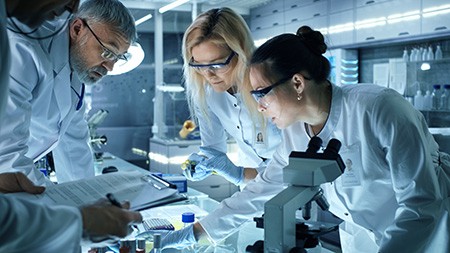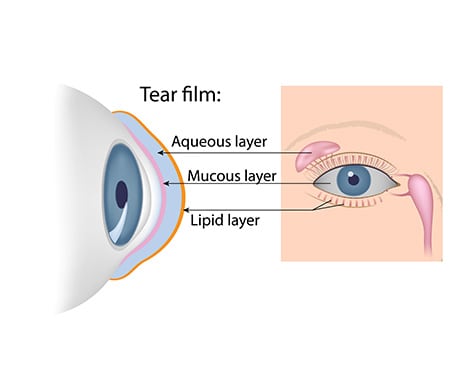
Dry eye disease does not have a simple fix or cure. This is a complicated and chronic condition, and each patient is unique because dry eye can be caused by many factors, from clogged eyelid glands and environmental concerns to certain medications or health conditions. Millions of people struggle with eye discomfort, redness, burning, stinging, and blurry vision caused by dry eye disease. While there is no cure, ophthalmologists can manage symptoms effectively with a combination of treatments.
At Laser Eye Center™, our experienced ophthalmologists are dry eye specialists, offering the latest medications and treatments. We take great pride in upgrading our techniques and equipment as technology advances to ensure our patients get excellent care from some of the best eye doctors in the region with state-of-the-art dry eye treatment.
Will We Find a Cure for Dry Eyes?
Dry eyes are a common problem linked to eye allergies, excessive screen time, medications, medical conditions, wind, air, dust, and other causes. Finding a cure for a disease caused by multiple issues and exposures is challenging. That’s why targeted treatments are more crucial.
Many therapeutic options are on the market, including three new dry eye treatment options in 2023 alone. Dry eye treatment has grown exponentially in the past 10 to 15 years, searching for a cure through a better understanding of what causes dry eyes.
Dry eye disease has two sub-types:
1. Evaporative Dry Eye
Evaporative dry eye is typically linked to meibomian gland dysfunction (MGD) or other issues with the eyelids or ocular surface. Someone with MGD has insufficient oil or lipid secretion from the meibomian glands lining their eyelids. The lipid or oily layer of the tear film is essential in making the tears stick to the eye. Without those secretions, the watery layer (aqueous) evaporates too quickly, causing dry eye symptoms.
The lack of meibum on the eye’s surface tells the lacrimal gland to create and release more aqueous tears, which leads to watery eyes. In other words, the lacrimal gland tries to compensate for the lack of oil, which worsens dry eye symptoms.
2. Aqueous Tear-Deficient Dry Eye
Aqueous tear deficiency accounts for just 10-15% of dry eye cases. Watery tears are released by the lacrimal glands found above the outer edge of the eyes. The lacrimal glands constantly release aqueous fluid to cleanse, protect, lubricate, and moisten the eye’s surface. These tears form the watery layer of the tear film. You can experience eye redness, pain, and blurry vision when there are not enough tears.

Aqueous tear-deficient dry eye is associated with Sjögren’s syndrome, a chronic autoimmune disorder that causes gland destruction in the lacrimal glands and salivary glands, leading to dry mouth and dry eye. This type of dry eye may also be caused by aging, lymphoma, sarcoidosis, viral infections, and damage to the lacrimal gland due to injury or radiation therapy.
Patients may have evaporative dry eye or aqueous tear-deficient dry eye, or both. Finding a cure for dry eye disease would require a cure for both sub-types but would not help patients whose dry eyes are caused by a larger health concern. Our best hope in improving dry eye disease is targeting the source, such as the meibomian glands, and managing symptoms.
Researching a Cure for Dry Eyes
The latest treatment strategies for dry eye disease include iLux²®, BlephEx®, intense pulsed light (IPL) therapy, and effective treatment for eye allergies. iLux²® technology offers meibomian gland imaging for proper diagnosis of meibomian gland dysfunction, and the iLux²® handpiece delivers light energy that warms and puts pressure on the eyelids to unblock the glands for better oil flow. BlephEx® cleans biofilm, bacterial toxins, and bacteria from the eyelids to improve eyelid hygiene and dry eyes. IPL therapy for dry eyes decreases inflammation and addresses bacterial infections with pulsing light energy that dislodges oil from meibomian glands for healthier tear film.
Complementary future treatments may involve creating specialized eye drops with the blood products, such as autologous or allogenic serum drops, platelet-rich plasma (PRP), and serum from umbilical cord blood. Autologous serum eye drops and PRP use a blood sample to isolate growth factors and create eye drops that work for your specific needs. The allogenic serum is taken from healthy blood donors. Stem cell therapy is also being used to study eye diseases, including dry eyes. These treatments offer promise for future methods that use your own or a donor’s tissues to address dry eye disease.
Someday there could be a cure for dry eye disease that targets the cause of each patient’s condition, but researchers are a long way from that. For now, our dry eye specialists have seen excellent results with iLux²®, BlephEx®, and IPL therapy.
Targeted Dry Eye Treatment in Place of a Cure

In lieu of a permanent cure for dry eye disease, ophthalmologists and patients have numerous options to maintain moisture and restore normal tear function. Dry eye disease management typically takes a combination approach involving removing or minimizing environmental triggers, such as wind or dust exposure, and restoring a functional tear film on the surface of the eyes with treatments from an ophthalmologist. If there’s an underlying cause, like a medication, then discontinuing the drug may eliminate dry eye symptoms.
Finding the proper dry eye treatment depends on the cause, which may involve:
- Expressing clogged meibomian glands with iLux²® treatments. Six clinical trials have demonstrated that iLux²® technology can increase meibomian gland function by 300% within four weeks and significantly reduce symptoms, such as grittiness and irritation.
- Removing biofilm and debris from under the eyelids with BlephEx®. In one study, dry eye patients with MGD experienced a 50% reduction in symptoms after treatment with BlephEx®.
- Blocking the tear ducts with punctal plugs for people with aqueous tear-deficient dry eye to prevent rapid tear evaporation. A prospective double-masked study showed punctal plugs reduced dry eye symptoms by 94.2%, and 77% of patients involved were nearly symptom-free.
Home modifications can relieve symptoms, including taking frequent breaks from screens and using lubricating eye drops while reading, watching TV, or working on a computer. Staying away from fans, vents, and other sources of blowing air or heat can help. Diet changes, warm compresses, and eyelid massages are additional options.
Schedule Your Dry Eye Consultation at Laser Eye Center™
If you struggle with dry eye symptoms, the best thing you can do for your eye health is to see an experienced ophthalmologist to discuss your symptoms and develop a unique dry eye treatment plan.
Laser Eye Center™ is SoCal’s most trusted refractive and cataract surgery center. Our doctors have helped hundreds of thousands of patients improve their eye health for over 30 years. Schedule an eye exam at one of our SoCal locations by calling (800) 649-2659.
SOURCES:
- https://perks.optum.com/blog/how-to-cure-dry-eyes-permanently
- https://www.aao.org/eye-health/tips-prevention/fix-dry-eye-treatment-eyedrops
- https://www.medicalnewstoday.com/articles/how-to-cure-dry-eyes-permanently
- https://www.health.harvard.edu/blog/the-latest-thinking-on-dry-eye-treatments-202210132833
- https://www.reviewofophthalmology.com/article/will-we-ever-cure-dry-eye
- https://www.aao.org/eye-health/tips-prevention/how-can-i-tell-whats-causing-my-dry-eye
- https://www.ncbi.nlm.nih.gov/books/NBK532914/
- https://www.reviewofoptometry.com/article/dont-overlook-aqueousdeficient-dry-eye
Schedule your free consult today
Click here to learn moreGet started on your journey to clearer, crisper vision with Laser Eye Center™. Our expert team of doctors are trained and skilled in the latest technology and methods for laser vision correction. To learn more about our state-of-the-art All Laser LASIK technology or about All Laser LASIK itself, contact us today. Schedule your FREE All Laser LASIK consultation by calling today.

